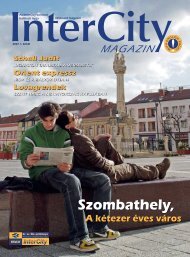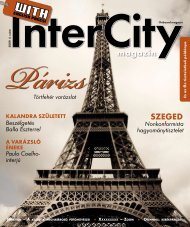InterCity Magazin 2008/tavasz
InterCity Magazin 2008/tavasz
InterCity Magazin 2008/tavasz
You also want an ePaper? Increase the reach of your titles
YUMPU automatically turns print PDFs into web optimized ePapers that Google loves.
<strong>InterCity</strong> <strong>Magazin</strong>ENGLISH CORNERENGLISH PAGESThen and nowAmong major cities Kecskemét, lying in thearea embraced by the Danube and the Tiszarivers, is the nearest to Pusztavacs, the geometricalcentre of the country. Kecskemétis the county seat of Bács-Kiskun and is theeighth largest city of Hungary. It is connectedto the capital city by the M5 motorway,consequently, the city is within a 45-minutereach of Budapest. The existence and quickdevelopment of Kecskemét, situated alongone of the most important railway lines(Cegléd-Szeged), are due to its geographicalposition from the very beginning.Its history dates back to ancient times.According to certain sources, the area wasinhabited as early as 3000 B.C. but archaeologistshave excavated artefacts from theBronze Age and from the Migrations Periodas well.History living with usThe seemingly dry historical facts can bebrought into a different light if we take atour round the city and get to know the locationsof the events that took place here.Kecskemét owns one of the smallest citycentres in Hungary, and it is worth startingoff from here. Secession had a great influenceon the city’s architecture and the TownHall, famous for its bell chime, designed byÖdön Lechner is no exception to this either.The assembly hall of the building is decoratedwith Bertalan Székely’s paintings.The city’s oldest building, the 14th- centuryFranciscan church is standing opposite theTown Hall. The former Franciscan monasterygives home to the Zoltán Kodály PedagogicalInstitute of Music. The next stop ofour journey is the József Katona Theatrenamed after the famous Kecskemét-bornplaywright. Although now a legend, JózsefKatona could not live to experience the suc-you can sense history on the streets. The spirits of Sándor petőfi, poet, JózsefKatona, playwright, and zoltán Kodály, composer, impregnate the city, whisperingancient Hungarian melodies and rhythms into your ears. Kecskemét, mothered bythe boondocks of the lowlands grew up long ago but kept all the primitive beautiesand secrets of the ancestral Hungarian landscape.cess of his works. His most important play,Bánk bán, written for a drama-competitionannounced by the Erdélyi Museum, wasturned down by the jury and it only wenton stage much later in 1833. From the theatre,we walk towards Kálvin Square, wherethe Classicist-style Old College stands, andopposite we can see the grand and imposingbuilding of the New College. The “CifraPalota” well-known by everyone, which, atthe moment, houses the Kecskemét Gallery,is only a few steps away from the aforementionedbuildings. The “Palota” with itspeculiar atmosphere, glazed ceramic tilesand Zsolnay tiles is really spectacular. Ourlast stop is the Great or Old Church locatedat the Main Square of the city. It is said tobe 200 years old, and that in the old days,the sound of its enormous bell weighing 2tons could be heard as far as Bugac.The „metropolis of theLowlands”The glorious past is only a small partof Kecskemét’s magic. It is not a coincidencethat year by year lots of Hungarianand foreign (mainly German and Dutch)tourists visit the city every summer. TheBohemian Ragtime and Jazz Festival,the International Air Show and the KecskemétAnimation Festival are all appealingprograms. It is worth knowing thatseveral successful, award-winning filmshave been (and are still being) createdin the local workshop, ones which haveearned international reputation for theHungarian cartoon-industry. Miraclesand legends have been born in this city.This is the city where the now world-famousKodály Method set out from. Thisis the city where József Katona and MiklósMelocco, sculptor, lived and created.Kálmán Latabár, actor, and Mária Mezei,KecskemétWhere legends are bornactress, were born here; artists whom thewhole nation can be proud of.This all creates the history of Kecskemét.A history that is not forgotten and thatstill lives on as a vital part of our present.Visitors indeed breathe in the spirit of theLowland’s traditions and they can hearZoltán Kodály’s melodies playing in theirears. He follows the footsteps of ancestorslike Sándor Petőfi, who called Kecskemét“the famous city”, or Mór Jókai, to whomKecskemét was “the metropolis of the Lowlands”.Those who visit here will find a citywhich blends ancient and modern, andwhich followed the words of time in a waythat it could preserve itself.Cobblestone walks in BratislavaThe city of sculpturesENGLISH PAGESfor those with a sweet tooth it’s a crescent roll, for those into legends it’s Kund the Diverwho first comes to mind. We tend not to include it on the list of favourite destinationsbut Bratislava is a city that is really worth the two-hour-journey.Before hitting the roadDue to its unique location, the capital city of Slovakiais rather near both the Austrian and theHungarian capital cities. From Budapest, Bratislava,located at the meeting-point of the threecountries, can be reached by train, by car andeven by ship. The latter is the most spectacularbut perhaps the costliest option as well, so, if youdo not want to spend too much, take a train or goby car. By Eurocity the Budapest-Bratislava linetakes 2 hours and 20 minutes, but even if you decideto catch a different train the journey won’ttake more than 3 hours. There are several trainsyou can choose from all through the week bothat Budapest Keleti (East) and Budapest Nyugati(West) Railway Stations, this way you can set offwhenever it is the most convenient for you. Thereare two things you cannot miss out on duringthe journey. One is the spectacular view of theDunakanyar (Danube Bend) which meets theeye when you cross the border at Párkány, andthe other is catching sight of the picturesque citycentre and the ethereal view of the New Bridge,on the top of which there is a restaurant.As the one in question is a capital city, it wouldbe really difficult to get to know all of it in twodays, but sadly it would not even be worth thetry. The suburbs fell prey to socialist architecture,thus, if it is possible, try not to look until youget to the real destination: the Old Town. Bratislava,as all cities, is about atmosphere. Don’t tryat all costs to see everything in full details in onlya few hours, you should rather let the magic ofthe city have its effect on you. Wander along thecobblestone streets, have a glass of Borovicka, ortry a slice of cake on the terrace of Mayer Confectioneryon the Main Square. Once the Bratislavaair has pervaded your body all over, then itis worth taking a better look around the city.Among kingsThe first stop of our historical walk could benothing else but the Castle. The magnificentsquare block with four towers and a museuminside rises high above the city. The castle canbe approached through 4 gates: from the East,through the Corvinus Gate built by King Sigismund;from the West, through the VienneseGate built by Charles III; from the Southwest,through the Crown Tower Gate, and from thestretch above the Danube, through the VictoryGate. After having seen the knights’ hall, thechapel and the restored rooms, you cannotmiss out on glancing down from the top of thecastle walls. From here we can see once morethe rope bridge (seen earlier from the windowof the train), a really capturing sight. The asymmetricbridge won the title of the Structure ofthe Century in Slovakia, which clearly showsthat locals are really proud of it. The edifice, ina league of its own in Europe, houses the UFObelvedere café in its pylon, which the adventurousand hungry tourists can reach by using anelevator.The most beautiful square of Bratislava is theMain Square (Hlavné námestie), with the RolandFountain in its centre dating back to 1512.One of the pedestrian areas of Bratislava witha really cosy atmosphere is Mihaliska ulica. Itis worth walking along it nice and slowly withyour eyes wide open because, perhaps, this isone of those areas of the city which offer themost historic sights. At the beginning of thestreet stands the only remaining gate of theOld City: the Michael Gate. The 51 meter-highedifice was originally to be built into a Gothictower but later, after several transformations itENGLISH CORNER<strong>InterCity</strong> <strong>Magazin</strong>was crowned with a Baroquedome with the statueof Saint Michael standingon top. The church andthe convent of the Clarissanuns are located near theGate and behind it risesthe 34 meter-high JagelloTower.TastingSlovakiaIf you get tired and hungryduring the journey, the small streets at the footof the Castle offer several opportunities fortasting local food and beer. One of the smallpubs is U Cera (To the Devil), where you canget cheap Demenovka, the Slovak version ofBecherovka. If you are near the Main Squareit is worth visiting either Ante Portas or PrasnaBasta. The latter is claimed to be one of thebest restaurants in town, and it would be foolishto leave without having a hearty and deliciousSlovak lunch here.Let us take a better look at what cannot bemissed: strapachka, of course, which is said tomake a lovely breakfast, an excellent lunch anda wonderful dinner. The ewe-cheese version isjust as worthy of trying as the one with braisedcabbage.As far as drinks are concerned, you cannot leavewithout tasting the beers and Borovichkagin. The most popular Slovak beer is still ZlatýBažant, which is perhaps not a coincidence. Ifyou are not in a hurry it is worth leaving timefor the exploration of the range of beers andfinding your favourites.Once you have strolled the narrow streetsand spacious squares of Bratislava,had a nice pint with the locals or takena glance at the broad River Danube runningthrough the city, you will see why itis well worth diverting from your usualand fashionable destinations every oncein a while.62<strong>InterCity</strong> <strong>Magazin</strong>spring <strong>2008</strong> <strong>2008</strong> spring<strong>InterCity</strong> <strong>Magazin</strong> 63














